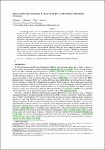Future of maritime autonomy: cybersecurity, trust and mariner's situational awareness
| dc.contributor.author | Palbar Misas, JD | |
| dc.contributor.author | Hopcraft, R | |
| dc.contributor.author | Tam, K | |
| dc.contributor.author | Jones, K | |
| dc.date.accessioned | 2024-03-21T12:36:16Z | |
| dc.date.available | 2024-03-21T12:36:16Z | |
| dc.identifier.issn | 2046-4177 | |
| dc.identifier.issn | 2056-8487 | |
| dc.identifier.uri | https://pearl.plymouth.ac.uk/handle/10026.1/22214 | |
| dc.description.abstract |
As technology evolves, the level of automation in the maritime industry also grows. Given the extensive benefits they offer, the industry will continue to develop its digital capabilities in order to improve. One key example of this is the industry currently striving for fully autonomous vessels. Current crew-based maritime operations on board rely on a mixture of automated simplistic processes, human decision-making, and human interventions. The future autonomy suggests the removal of the mariner physically on board. The remote nature of these operations will subject mariners and vessels to new operational risks, such as a potential reduction in Situational Awareness (SA) and/or cyber threats. In this research, authors engaged with navigators with a range of traditional operational experiences to extend previous discussions conducted with cadets on the importance of SA in maritime operations, and the potential challenges facing this when engaging in remote operations. This was done using tabletops, questionnaires and full bridge simulator exercises. Through this engagement, authors found that future navigators will need training to be equipped with new skills to interact with digital systems during different modes of human operation (such as remote monitoring, supervision and intervention) to overcome perceived challenges including cyber incident management. | |
| dc.format.extent | 1-12 | |
| dc.language | en | |
| dc.publisher | Informa UK Limited | |
| dc.title | Future of maritime autonomy: cybersecurity, trust and mariner's situational awareness | |
| dc.type | Journal Article | |
| plymouth.publisher-url | http://dx.doi.org/10.1080/20464177.2024.2330176 | |
| plymouth.publication-status | Published online | |
| plymouth.journal | Journal of Marine Engineering & Technology | |
| dc.identifier.doi | 10.1080/20464177.2024.2330176 | |
| plymouth.organisational-group | |Plymouth | |
| plymouth.organisational-group | |Plymouth|Faculty of Science and Engineering | |
| plymouth.organisational-group | |Plymouth|Faculty of Science and Engineering|School of Engineering, Computing and Mathematics | |
| plymouth.organisational-group | |Plymouth|REF 2021 Researchers by UoA | |
| plymouth.organisational-group | |Plymouth|Users by role | |
| plymouth.organisational-group | |Plymouth|Users by role|Current Academic staff | |
| plymouth.organisational-group | |Plymouth|REF 2021 Researchers by UoA|UoA11 Computer Science and Informatics | |
| plymouth.organisational-group | |Plymouth|REF 2029 Researchers by UoA | |
| plymouth.organisational-group | |Plymouth|REF 2029 Researchers by UoA|UoA11 Computer Science and Informatics | |
| plymouth.organisational-group | |Plymouth|Users by role|Current Post-Graduate Research students | |
| dc.date.updated | 2024-03-21T12:36:15Z | |
| dc.rights.embargodate | 2024-03-23 | |
| dc.identifier.eissn | 2056-8487 | |
| rioxxterms.versionofrecord | 10.1080/20464177.2024.2330176 |


